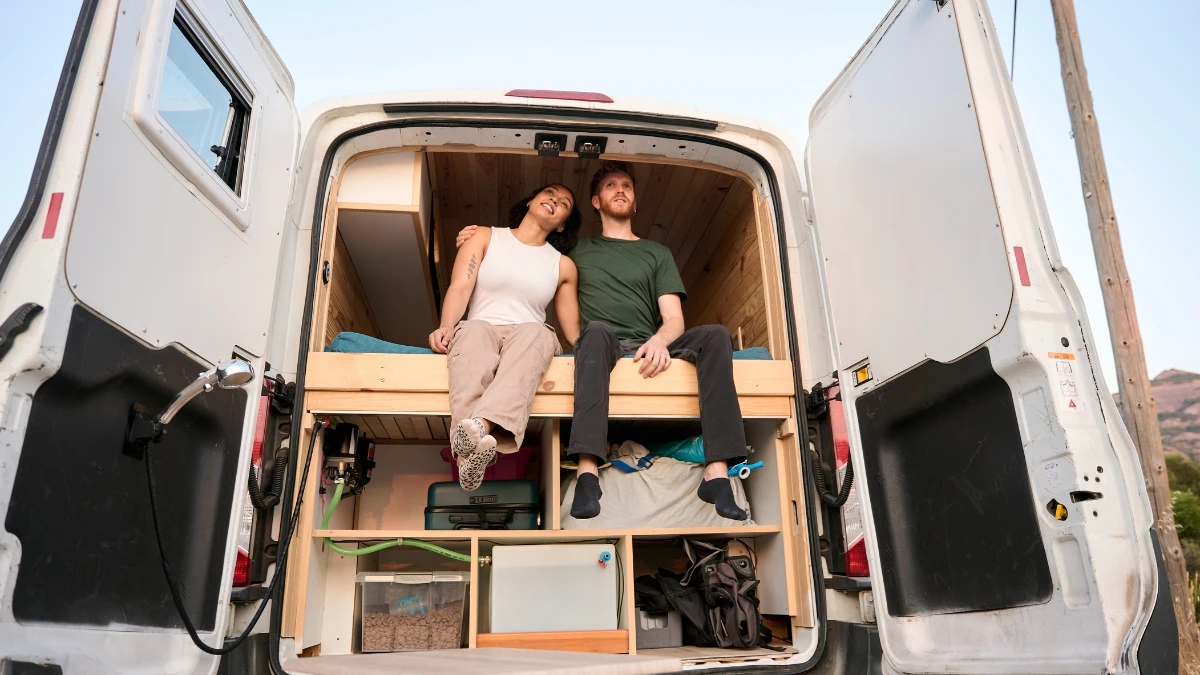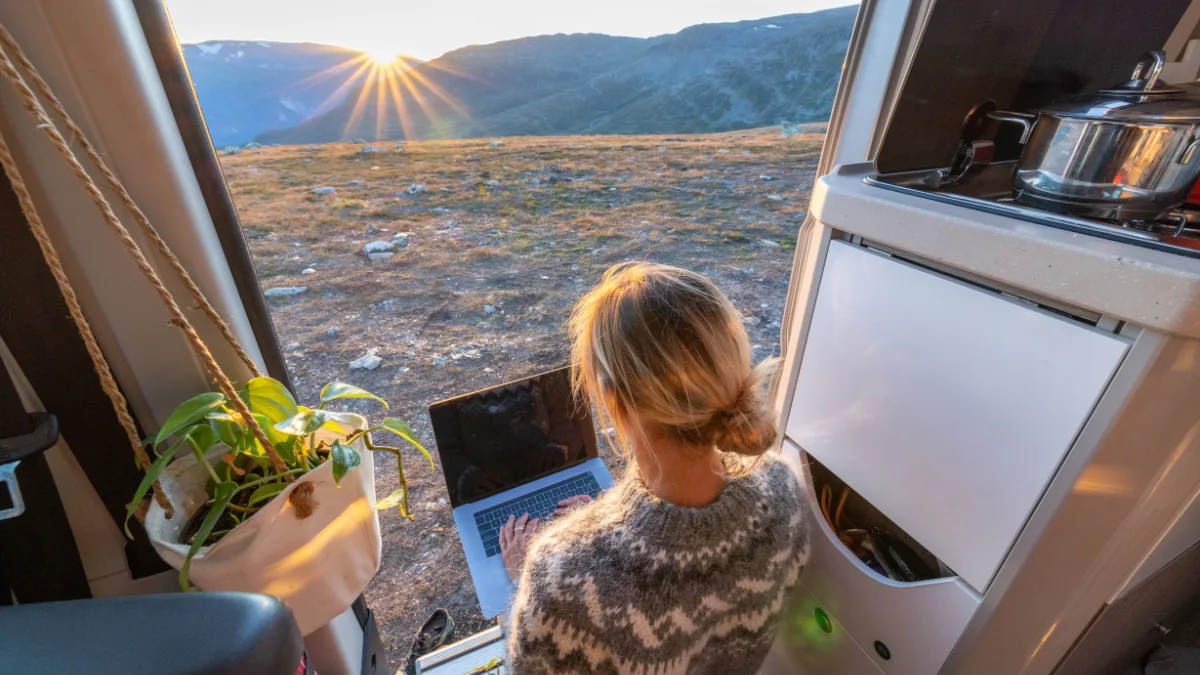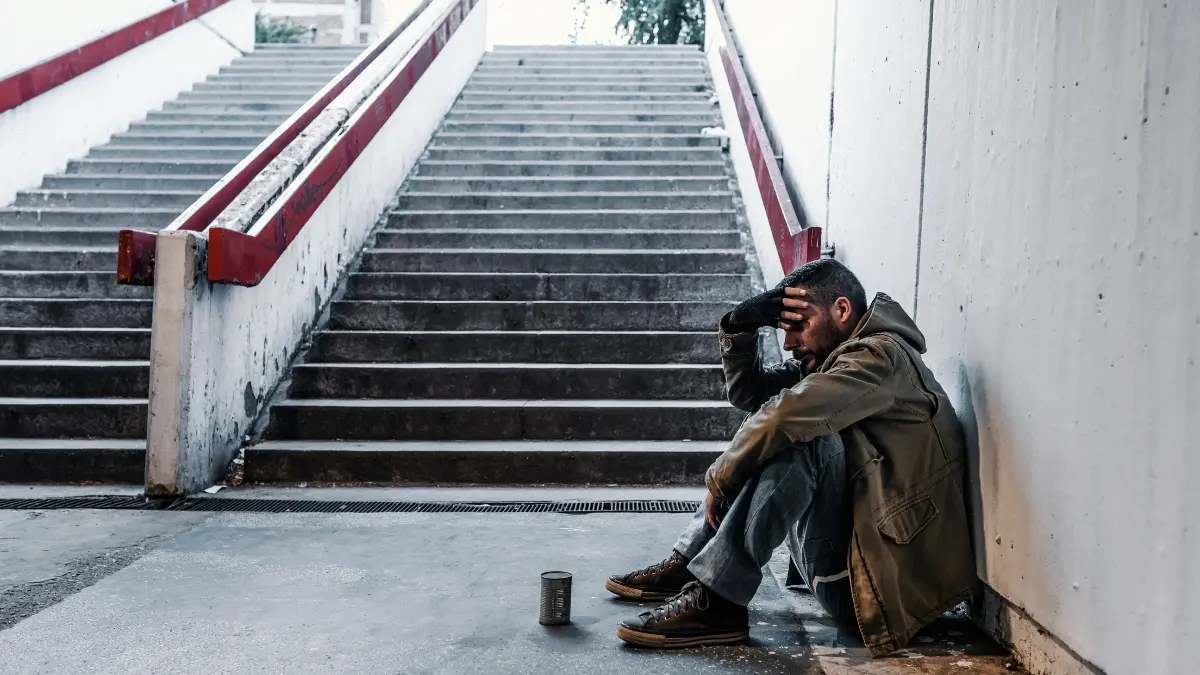You’ve seen the pictures: a perfect van, a stunning sunset, and a caption about total freedom without rent or routines. This carefully curated fantasy is sold to a generation desperate to believe in an affordable escape.
But this romanticized image is a dangerous myth that hides a grim reality. For every flawless photo, there is the jarring knock of a police officer, the terror of a flash flood, or the soul-crushing moment an engine seizes. The van life dream is a direct path to financial ruin and a precarious existence that is simply glorified homelessness.
The #VanLife Dream Is a Lie
The #Vanlife Myth: Dream vs. Reality
The Instagram Fantasy
“All you see are perfect views, total freedom, and captions about ‘living the dream.’ It’s sold as an escape from rent and rules.”
The Financial Reality
-
1.Upfront Cost: A reliable, converted van often costs $40,000 – $80,000+, far from a “cheap” alternative.
-
2.“Van Rent”: Monthly costs for fuel, insurance, and repairs average $1,200 – $2,500—a new form of rent.
-
3.Breakdowns: A 2022 report noted 60% of full-time vanlifers face an “emergency” repair (avg. $1,500+) within their first year.

You’ve seen the pictures. A perfect van, a perfect view, and a caption about living free. It looks like a dream come true: no rent, no rules, just open road. It’s a beautiful story sold to a generation that desperately wants to believe it.
But that perfect picture is hiding a much darker reality. For every pretty sunset, there’s a cop knocking on the window at 3 a.m., telling you to move. For every scenic mountain, there’s a flash flood that turns your home into a waterlogged trap.
And for every post about “living the dream,” there’s an engine failure in the middle of nowhere. That’s the moment your van stops being a symbol of freedom and becomes a thousand-dollar problem. That’s the moment you go from being a “nomad” to just being homeless.
The truth is, the #vanlife you see on Instagram is a dangerous and expensive myth. It’s pushed by influencers who make it look easy, but it often leads to financial ruin and serious stress. It blurs the line between choosing a lifestyle and having no other choice.
This article will pull back the curtain on the big lie. We’ll show you the true financial costs, why so many people are falling for the fantasy, and the heavy emotional toll it takes. The open road isn’t the escape you think it is. For many, it’s just a beautifully decorated dead end.
The True Price of “Freedom”

The biggest promise of van life is that you’ll save money. No more rent, no more mortgages. But when you look at the real costs in 2025, that promise falls apart. The dream of a cheap, simple life has been turned into an expensive industry that can leave you in a worse financial spot than where you started.
Why That “Cheap” Van Costs More Than a House Down Payment
First, you need a van. The ones you see all over social media aren’t cheap. A new Mercedes Sprinter can cost you $60,000 to $85,000—and that’s before you’ve built anything inside. Even cheaper options like a Ford Transit or Ram ProMaster start at around $45,000.
Many people look for a used van to save money. You might find an older one with high mileage for $10,000 to $18,000. But this is a huge risk. An old engine or transmission can fail at any moment, leaving you with a repair bill that costs thousands of dollars.
Once you have the van, you have to turn it into a home. This is where the costs really start to add up.
You can hire a professional company to build it for you. This is the easiest route, but it’s also the most expensive. A professional conversion can cost anywhere from $40,000 to over $100,000. A top-of-the-line build can easily cost more than $200,000. At that point, you’re not escaping the housing market; you’re just buying a luxury vehicle.
Or, you can build it yourself. The DIY route is sold as the smart, cheap option. But it often turns into a nightmare that drains your bank account. One person started with a $5,000 budget that ballooned to $15,000 by the time they were done. Here’s why:
- Insulation: To stay warm in the winter and cool in the summer, you’ll spend $500 to $1,500.
- Electrical System: For lights, charging your phone, and running a laptop, a good solar-powered system will cost between $4,200 and $14,000.
- Plumbing: Even a basic sink and toilet can cost you $500 to $2,000.
These aren’t fancy extras; they are the basics you need to live. For many, the DIY path is not a money-saver. One person called it a “soul-sucking, time-devouring, mental black hole” that left them burned out before they even started their journey.
How “Living for Free” Drains Your Bank Account Every Month

The big upfront cost is just the start. Living in a van comes with a steady stream of monthly bills that prove “living for free” is a myth. The average person spends between $800 and $3,000 a month on the road.
Gas is your biggest and most unpredictable expense. You can expect to spend between $200 and $600 a month on fuel. This alone makes the freedom to travel too expensive for many.
Insurance is another bill you can’t avoid. Your regular car insurance won’t cover a van that you live in. You’ll need special RV insurance, which costs between $75 and $200 a month.
Repairs are a constant threat. You should budget $50 to $400 a month for basic things like oil changes. But that doesn’t cover a major breakdown, which is bound to happen when you’re putting so many miles on your vehicle.
And what about a place to park? “Free” camping on public land is getting harder to find and often isn’t very safe. If you want to stay in a real campground with electricity and water, you’ll have to pay. Fees can run up to $900 a month, with some spots costing over $30 for a single night. When you add it all up, van life isn’t cheaper than a small apartment. You just trade one predictable rent payment for a dozen unpredictable expenses that are often much higher.
The Real Cost of a Breakdown: More Than Just a Repair Bill
The biggest financial risk of all is a mechanical failure. A breakdown can destroy your plans and your budget in an instant. It’s not just an inconvenience; it’s a full-blown crisis.
One van lifer tells a story of breaking down in a tiny desert town. She was living on only $150 a month. A single night in the local motel would have cost $80—more than half her budget for the entire month. She was lucky to have a friend nearby and avoided sleeping behind a dumpster.
A breakdown is more than just the repair bill. It’s the cost of a motel because your home is in the shop. It’s lost income if you can’t get online to do your remote job. It’s the stress of finding a mechanic you can trust in a town you don’t know. It’s the awful feeling of having your home and your transportation taken away from you at the same time. This is when the adventure ends and the hard reality sets in: you are stranded, vulnerable, and homeless.
Why the Lie Is So Seductive

The van life trend didn’t come out of nowhere. It’s popular with Millennials for a reason: this generation is facing a massive economic crisis. The idea of a cheap, free life on the road sounds amazing because normal life has become so hard. For many, van life isn’t a choice they make because they have options. It’s a choice they make out of desperation.
Why Van Life Looks So Good When You’re Drowning in Debt
To get why van life is so appealing, you have to look at the economy Millennials are dealing with. It’s an economy built on debt. The average Millennial has over $6,900 in credit card debt, often used just to pay for basics like groceries.
On top of that, there’s student loan debt. Millennials hold the largest share of the nation’s $1.64 trillion in student loans. Many are falling behind on their payments. Add in car loans, and the total debt for this generation is over $5.23 trillion.
At the same time, the housing market is out of control. Buying a house or even affording rent is impossible for many. This is where van life marketing gets really clever. It takes the feeling of being locked out of the housing market and turns it into a cool, minimalist choice. It says, “You don’t need a house, you can have an adventure!” The van becomes the only “home” that feels possible.
How Inflation Makes Van Life a Financial Trap
The economy of 2024 and 2025 has made van life even more of a trap. The same things that make normal life expensive are making van life a financial disaster.
First, gas prices are still high. The national average is around $3.85 a gallon, but it can be over $4.50 in popular places like California. This makes traveling, the whole point of van life, incredibly expensive.
Second, the vans themselves are still expensive. The used car market never went back to normal after the pandemic. It’s harder than ever to find a cheap, reliable used van.
Finally, the cost of everything else, from food to repairs, is up. Any money you might save on rent gets eaten up by the rising cost of just staying alive on the road.
It’s a trap. The financial problems that push people into van life are the same problems that make van life so expensive. This trend isn’t about people wanting a simpler life. It’s a reaction to a system that has failed an entire generation. The van life industry is just good at taking that desperation and selling it back to people as a cool lifestyle.
From “Houseless” to Homeless

The sharpest criticism of van life is that it’s just “glorified homelessness.” This gets to a tricky debate about choice, privilege, and what a home really is. People in the van life community like to say they are “houseless by choice.” But the legal and social reality shows that the line between choosing this life and being homeless is not just blurry—it’s disappearing.
Are You Choosing Van Life, or Are You Just Homeless With Better PR?
The whole debate comes down to one word: choice. The typical van life influencer has the privilege of choice. They usually have a good remote job, money from family, or a big savings account to fall back on. Their van isn’t their last resort; it’s an expensive toy for their adventures. If something goes wrong, they have a way out.
This is completely different from the growing number of people who are forced to live in their cars. They aren’t chasing adventure; they are running from high rents, a lost job, or medical bills. For them, a vehicle is the “housing of last resort.” They don’t have a safety net. One big repair bill or a medical emergency can push them from living in their car to living on the street.
The uncomfortable truth is that the #vanlife trend has made a romantic lifestyle out of something that is a grim reality for others. It’s built on a privilege that makes the struggles of truly homeless people invisible.
Why the Law Sees Your Van as a Problem, Not a Home
While people can debate the social side of things, the law is very clear. If you do not have a fixed, permanent address, you are legally considered homeless. It doesn’t matter how much money you make or how expensive your van is. This is a hard fact, and it’s why living in a vehicle is becoming a crime.
All across the country, cities are passing laws that make it illegal to live in a van. They are banning overnight parking on public streets. You’ll see signs that don’t just say “no camping,” but “no dwelling in vehicles.” This makes the simple act of existing in your own home a crime. The fines can be as high as $500, which can be a crushing blow if you’re on a tight budget.
Ironically, the fancy look of modern vans makes them a bigger target. Solar panels, roof vents, and bike racks are now red flags for police, signaling that someone is living inside.
This crackdown is being pushed from the top. A 2025 executive order is pressuring cities to clear out anyone living in public spaces. These laws don’t care if you’re in a $150,000 camper or a broken-down car. The law treats everyone the same, erasing the line between a lifestyle choice and homelessness.
This creates a serious legal problem. Your house has strong protection from police searches under the Fourth Amendment. Your car has very little. When your house is a car, you get the weaker protection. This opens you up to constant police intrusion. The van life trend, started by a few privileged people, has made life harder for everyone living in a vehicle. It has given politicians a reason to pass laws that hurt the most vulnerable people—those who were living in their cars out of necessity long before it was a hashtag.
The Unseen Toll: The Daily Grind Behind the Pictures

Behind the perfect photos is the reality of living in a van. It’s not a life of fun and adventure. It’s a stressful, exhausting grind filled with anxiety and loneliness. This is the part of van life that never makes it to the Instagram feed, and it’s why so many people burn out.
The Never-Ending To-Do List That Replaces Your 9-to-5
Van life promises freedom from your boring daily routine. But in reality, you just trade one routine for another one that is much harder and more stressful. The “freedom” of the open road is an illusion. The real experience is a constant battle with logistics.
Your day is filled with tasks that are anything but glamorous. You are always worried about resources: finding fresh water, dumping your dirty water, getting more propane for your stove, and making sure your batteries are charged so you can work.
The most stressful question you have to answer every single day is, “Where am I going to sleep tonight?” The search for a safe and legal parking spot is a daily struggle. You often end up not in a beautiful natural spot. But in a noisy Walmart parking lot or on a dark street, always worried about getting that knock on your window.
Even simple things become a challenge. Cooking is done in a tiny space. Washing dishes is a puzzle of how to save water. The small space means you have to be cleaning and organizing all the time. And without a real bathroom, you have to rely on public restrooms. It’s a life of discomfort. As one person put it, “Cold is colder, hot is hotter, dirt is dirtier.”
Why You Can Feel So Lonely in the Most Beautiful Places
This constant grind takes a huge mental and emotional toll. Van life is a “relentless test of your nerves, resilience, and patience.” When you combine that pressure with the loneliness of the lifestyle, you have a recipe for a mental health crisis.
The strange thing about the open road is that you can be in the most amazing places and still feel completely, crushingly alone. It’s almost impossible to build deep friendships when you’re always moving. Most of your conversations are with a barista or a mechanic. You miss out on the basic human need for community and connection.
This loneliness, mixed with the daily stress, leads to anxiety and burnout. You are constantly making decisions: where to park, which road to take, when to buy groceries. This leads to “decision fatigue.” The lack of stability is emotionally draining.
Feeling Safe Is a Full-Time Job
The final hidden stress is the constant feeling of being unsafe. The cozy picture of a van as a “home” hides the fact that it’s just a metal box on wheels, open to all kinds of threats.
Your personal security is always on your mind. A van full of your things is a target for thieves. You always worry about a break-in. For solo travelers, especially women, these risks are even greater and require a level of awareness that is exhausting.
Then there are the dangers from the environment. You are exposed to the weather in a way people in houses are not. A sudden rainstorm can cause a flash flood that traps you. A snowstorm can leave you stranded and freezing. A heatwave can turn your van into an oven.
Finally, getting sick on the road is a serious problem. You are often far from doctors and don’t have the comfort of a real home to recover in. A simple flu can turn into a major ordeal.
Conclusion
For many people, the van life journey doesn’t end in freedom. It ends with a quiet and painful decision to quit. The “Great Resignation” from the 9-to-5 job is often followed by a great resignation from the van itself. The stories of people who have quit are the final proof that the Instagram dream is a lie.
They quit because they were lonely and needed the stability of a real community. They quit because they were exhausted from the daily grind and the constant stress. They admit the “freedom” they were promised was just another set of anxieties that kept them from moving forward with their lives.
So why does the myth of van life continue? It stays popular because it speaks to the real problems a generation is facing. The dream of escape, of an affordable life, and of finding meaning is a powerful idea when you’re facing a future of debt and a housing market you can’t afford. The lie is so attractive because the truth is so discouraging.


